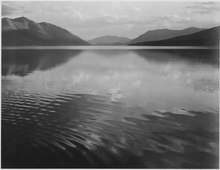Black-and-white
This article needs additional citations for verification. (March 2013) |

Black-and-white (B/W or B&W) images combine black and white in a continuous spectrum, producing a range of shades of gray.
A picture which uses only the two shades of white and black would look similar to a silhouette. Therefore, calling a photo a "black and white image" is actually a misnomer.[1][failed verification][2][failed verification] The technically accurate term is "grayscale", or more specifically "grayscale monochrome". A picture which consists only of actual white and black pixels is a "binary image".[citation needed]
Media
The history of various visual media has typically begun with black and white, and as technology improved, altered to color. However, there are exceptions to this rule, including black-and-white fine art photography, as well as many motion pictures and art films.
Photography

Contemporary use

Since the late 1960s, few mainstream films have been shot in black-and-white. The reasons are frequently commercial, as it is difficult to sell a film for television broadcasting if the film is not in color. 1961 was the last year in which the majority of Hollywood films were released in black and white.[3]
Computing
In computing terminology, black-and-white is sometimes used to refer to a binary image consisting solely of pure black pixels and pure white pixels; what would normally be called a black-and-white image, that is, an image containing shades of gray, is referred to in this context as grayscale.[4]
See also
- dr5 chrome
- List of black-and-white films produced since 1970
- Monochromatic color
- Panchromatic film
- Selective color
References
- ^ [1], How to Photograph the Outdoors in Black and White, by George Schaub · 1999, page 93, published by Stackpole Books (ISBN 9780811724500)
- ^ [2], The Photographic Garden Mastering the Art of Digital Garden Photography, by Matthew Benson · 2012, page 108, published by Potter/Ten Speed/Harmony/Rodale (ISBN 9781609610883)
- ^ Robertson, Patrick (2001). Film Facts, Billboard Books, p. 167. ISBN 9780823079438
- ^ Renner, Honey (2011). Fifty Shades of Greyscale: A History of Greyscale Cinema, p. 13. Knob Publishers, Nice.

